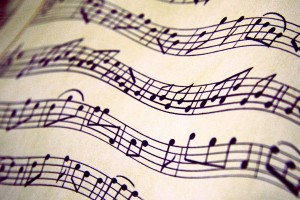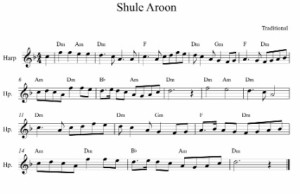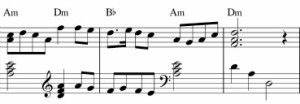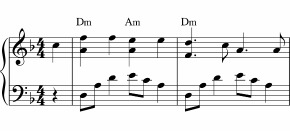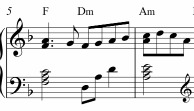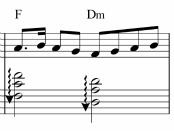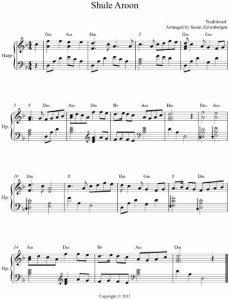Taking Your Arrangements to the Next Level
One of the things I’ve been asked recently is how to take your music arranging for Celtic harp to the next level. What kind of advanced techniques will carry you beyond the boring left hand accompaniment below the plain melody?
To answer that question, I’ve decided to take you through an arrangement, from finding your own chords to creating patterns that emphasize the drama of the melody and lyrics. I’ve chosen a favorite tune, Shule Aroon.
I’ve found two versions of the tune online, one of which has an accidental in it. I’ll choose the one without accidentals, just because the tune is more familiar to me that way. (Music arranging is largely about preference, as you’ll see as I take you through my process). You can find a copy here.
Advanced Music Arranging for Celtic Harp: Preliminary Steps
I’ll also add the dotted rhythm I’m used to hearing in this tune (in measures 7 and 15, which you can see in the melody with chords lower down the page).
Next, before I do any arranging, I’m going to transpose the tune. Why? Right now it’s in Am, which is the relative minor key that goes with C major. (You can tell it’s minor not only because of its plaintive sound, but by the face that the melody begins and ends on the note A instead of C. Every key has a relative minor, a scale that begins and ends on the sixth note of the major scale).
I’d like the piece to fit on my therapy harp, which goes down to the C below middle C. Therefore, I don’t have that lovely low A to anchor the A minor chord, which leaves me with two choices: move the tune up an octave to allow for Am arpeggios, or transpose to a key that fits the harp more nicely. I could choose C minor, given that bottom string is C, but I’m going to choose D minor instead. D minor is relative to which major key? If you count down six strings from the D string, you land on F. F major has one flat, a b flat, so that’s what goes in our new key signature.
Next, I’ll look at how far away D minor is from A minor. It’s either 5 strings lower or 4 strings higher (be sure to count the starting string). Since I’m interested in creating more room for the left hand, I’ll choose to count up 4. Now all I have to do is look at each note in the melody and raise it by 4 strings. G becomes D, C becomes F, B becomes E, and so on. Of course, you can use a music notation program to help you with this step, but doing it yourself until you understand it will make you much more able to transpose “on the fly”.
Now we’re ready to find the chords. If you haven’t already, download the pdf from My Harp’s Delight called Building Chords on the Scale: building-chords-on-the-scale
This chart will really help you when you’re arranging harp music. Find the chords that apply to F major and D minor, on page three. You’ll notice that the chords follow the same pattern from every major scale: major, minor, minor, major, major, minor, diminished (the last chord is the same as the first chord, one octave higher).
Here’s a great online tool for visualizing the chords that go with any scale. (Link opens in a new window). Just choose “D” from the list of notes, and N.Minor/Aeolian from the list of modes (N stands for natural minor). The chords that fit D minor will be automatically highlighted, with their quality (major, minor, diminished) listed on the outside ring.
Advanced Music Arranging for Celtic Harp: Finding the Chords
Before we can do any arranging, we need to find our harmony. Let’s look at the first beat of each measure in Shule Aroon and figure out which chords might fit. It’s a pretty safe bet that the first chord will be Dm, since harmony usually starts “at home” with the first degree of our scale. The melody note is F, which is the middle note of a Dm chord.
There will be two other chords on the chart for this key which also contain the note F; can you find them? That’s right, the F chord and the Bb chord both have an F in them. This is true for every note–it can always be found in three different chords within the key. So at a basic level, all you have to do is try the three chords with your given note and see which one “sounds” the best.
You will notice that you can play that first measure over any of these chords. Using unexpected ones can spice up a tune, but sometimes it just sounds bizarre.
Keep looking at the notes on beat one and choosing your chords. Overall, I’m going to choose more minor than major chords, since we’re after a plaintive sound to match the melody and the lyrics. Rarely will you want a diminished chord, so there are usually only six chords to even consider throughout the piece.
Since this is such an active melody, it sometimes suggests the need for a second chord, on beat 3. Not every measure needs a new chord on beat 3 (in which case you leave it out and let the first chord continue). Look for these next, and choose chords that highlight the moving quality of the tune.
You may also have noticed that this tune falls into two halves, each 8 measure long, and actually it has a verse/chorus form. The chorus is almost the same as the verse, so I’m choosing to use the same chords. Another option would be to deliberately make them different. Experiment and decide what you like best.
It’s time to play the whole tune, adding simple triads with your left hand. Make any changes and we’ll be ready to go on to arranging. (click on any image for a larger version)
Advanced Music Arranging for Celtic Harp: Where to Start
Here’s my best tip for arranging. Do NOT start at the beginning. I’ve learned that the most helpful and fun way to go about arranging to is start with the prettiest, most interesting points of the melody. These are usually, but not always, found just before cadence points (the ends of phrases, those places the melody rests and the singer takes a breath before going on). Measures 7 and 8 grab my attention immediately. This is the climactic moment of this melody line, and also happens to be the refrain (the words mean, “And safe for aye may my darling be!”, so this is where the singer is begging for the safe return of her lover). I want to do something with the accompaniment that underscores her plea.
Here are some arranging ideas that spring to mind: parallel or contrary motion, dramatic rolled chords, and definitely a downward arpeggio for that last melody note in measure 8. I like using parallel motion, in sixths, for the first half of measure 7, then a dramatic rolled chord, then the arpeggio. In fact, the parallel motion can start in the last half of measure 6, for even more drama. I’ll need to put the left hand in the treble clef and then simply follow the melody, a sixth lower (this is similar to transposing, and one of the reasons you want to understand your intervals).
You might notice a couple other things here: firstly, I’m no longer playing the Dm or Bb chords I chose, but using a counter melody to create the harmony; and secondly, I’ve left out the dotted rhythm in the left hand to give a nice little offset effect.
(Now, if I’ve lost you, and you want a tutorial on doing more basic music arranging using the chords, check out my beginning tips for music arranging on this page).
Advanced Music Arranging for Celtic Harp: Next Steps
Now, since I like this passage and I want to emphasize the repetition of music and lyric, I’m going to use it again at the end of the chorus. If this arrangement was for a bigger harp, I’d probably put that Am chord down lower and use an open voicing, but I can’t do that in this version.
Looking at the score, I notice next what varies between the verse and the chorus, and I decide to play up those differences with different accompaniment ideas as I’m arranging. Measures 1 and 9 are very different rhythmically, a fact I decide I want to emphasize in my arrangement. So I’ll use big chords under the half notes in measure 9, and moving notes under the quarter notes in measure 1. (The opposite choice would be equally valid, and would produce a sound of constant motion, but I like giving the ear more variety).
In measure 1, I have an Am chord and the limitation of the harp (no low A), so I have to break my pattern. Why not make that into a feature? I’ll let the Am chord ripple downwards. Nice sound for the left hand, no? I like it so much that I’ve repeated it in measure 2, and I’m going to remember to play with changes of direction in other spots.
How about measure 9? Since I want big rolled chords, what if I rolled them downwards? I love that authentic, old Celtic harp sound (it was the Victorians who decided chords should roll upwards, or so I’ve been told). I love thinking about these sorts of things when I’m working on arrangements.
Keeping in mind my lack of a low A, I’ll put the Am chord in an inversion, therefore keeping the movement from chord to chord simpler for the player as well. To make a fuller sound, I’m going to add intervals under the melody notes in the right hand, but I will avoid three-note chords that would have to be rolled since the left hand has the starring role here. I decide to repeat the first chord in the next measure as well, and my ear wants me to throw in that extra 4th (essentially another chord–Am–but it certainly fits the melody).
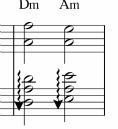
Looking for other spots to change direction, I realize that there are also passages that would be lovely with some contrary or parallel motion. Measure 3, for starters. In measure 4, I’ll return to my opening arpeggio, but this time do something different for the second half. I don’t want to wear out that climbing down idea.
Advanced Music Arranging for Celtic Harp: Taking it Further
The first half–the verse–is almost done. I’m just going to fill out measures 5 and 6 using the alternating chord and arpeggio idea I used in measure 3. Finally, I’ll add some supporting notes to the right hand to make it fuller (and easier to play). A few extra rolled chords there, since they’re so pretty on the harp . . .
What about the chorus? Music, and therefore music arranging, is always about balancing repetition and novelty. Of course, I could copy exactly what I did on the verse, since the melody in measures 11-14 is identical. I already copied the last three bars, remember? I’d rather add variation to what I did before, to continue making the chorus stand apart more. I’m going to slow down the rhythm with quarter notes and try a descending F arpeggio in measure 11.
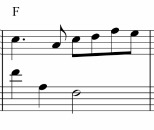
I like that, and I really like what I did in measure 4 so I will go ahead and do that again in measure 12. I’ll change tack again in measure 13 and use my downward rolled chords idea, just to echo the drama from the opening of the chorus in measures 9-10.
laying through the whole thing on my harp, I like the changes in direction, including those between the standard upward-rolled chords and the downward ones, and I like the balance of arpeggio and chord (too many of either makes for a bland sound, to my ears). Of course, I could arrange more verses, add an introduction and/or interlude, or play with different chords, but for now I’m content with this piece.
Now that I’ve walked you through my approach to arranging for Celtic harp, what do you think?
I know that’s too small for you to see, so here’s a free PDF version of Shule Aroon to download: shulearoon
Ask a question about Music Arranging: Advanced Techniques here

